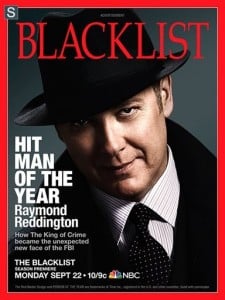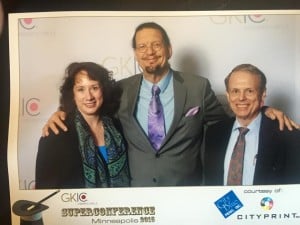 How Watching “The Blacklist” Can Improve Sales
How Watching “The Blacklist” Can Improve Sales
Raymond Reddington of NBC’s “the Blacklist” seems an unlikely hero in an era when spy dramas are full of cgi car chases and supernatural martial arts skills.
However . . .
The scene opens on a darkened roomful of good guys and bad guys in an eerie warehouse in the bad part of town. The tension is high and you sense that this is the moment just before the bullets start flying.
“Red” Reddington is a Consummate Storyteller.
Raymond “Red” Reddington strides confidently in the room his assistant Denbe at his side. He flashes a high-beam smile at the assembled crowd, throws his hat down on a chair, and starts telling a story.
“Steve! I’m delighted to see you. It’s been ages. You know, this reminds that time in Namibia. A woman I was dating was so convinced there was a bomb in a package that she threatened the mailman with a bowling pin. You know, she made the most amazing pie crusts . . . ”
The Parable of the Farmer from the Blacklist
What’s remarkable about Reddington’s character is that he doesn’t (usually) pull a gun, (at least not right away) he doesn’t raise his voice or show anger, and before anyone realizes what has happened, he has taken control of the room, using nothing more than an affable presence and a finely-honed skill for storytelling.
And by the time he finishes his story, most likely the good guys, and bad guys (according to the story line, Reddington is a bad guy, although that’s easy to forget because he is so good at it) are placidly, if bemusedly, doing Red’s bidding. At least for the moment. People have begun to know, like, and trust him, in spite of his reputation, and in spite of their own agendas.
In real life as well as on TV, storytelling is a fantastic technique for convincing people to do what you want. Or at least, getting them to stop and listen to you.
The success of the show itself is evidence of the power of great storytelling. (Even TV watchers love great stories!)
On May 11, 2014, owing to the show’s breakout success, NBC announced the show would air an episode in the coveted post–Super Bowl timeslot in 2015.
The show has received critical acclaim, with many critics praising Spader’s performance in particular.
Wikipedia – The Blacklist – TV Series
Why is storytelling so successful? (And more importantly, how can you USE this to be more successful with your sales and marketing efforts?)
 James Spader is not the only gifted storyteller we’ve seen lately. We had the opportunity to see Penn Jillette (of Penn & Teller) at the GKIC Marketing Superconference last week in Minneapolis. There is another man with amazing storytelling skills.
James Spader is not the only gifted storyteller we’ve seen lately. We had the opportunity to see Penn Jillette (of Penn & Teller) at the GKIC Marketing Superconference last week in Minneapolis. There is another man with amazing storytelling skills.
While people think of Penn & Teller as a magic act, the real talent comes in great storytelling. Penn Jillette started as a street performer. He used stories and humor to draw a crowd, to explain each “trick” as it was being performed, (magicians notably call this “selling the trick”) and, most importantly to the success of a street performer, to get people to actually want to give him money at the end of his act. He was so successful that his accountant was certain he was selling drugs or doing something illegal. (Like, street performers make enough money to need an accountant?)
Here’s why they work:
- Stories get attention. From the time we were children, we learned to stop what we were doing and listen as soon as someone (particularly a gifted storyteller) started telling a story.
- Stories are a pattern interrupt in a marketing or selling situation. People are expecting a barrage of reasons they should buy your product. By slowing down the interaction and telling a story, the prospect (who was gearing himself up to object or resist your sales or marketing efforts) is caught off guard.
- Stories are disarming. In the case of the TV show, stories can be literally disarming. But in your case, you don’t need to convince a gang of mobsters to stop what they’re doing mid-attack. As a salesperson or marketing professional, you’re more likely to encounter skepticism and cynicism than outright violence. (We hope!)
- Stories build rapport. Particularly if you use a story that connects with something you know about the prospect. Telling a story that includes an element that you know about your prospect (the town he came from, a school he graduated from, a sport he played, etc.) you can very subtly but powerfully build a very real connection in the process of telling a story.
- Stories are convincing. The stories you choose can be case studies or narratives about customers who achieved a particular result form using your product. Facts and statistics are one thing, but a great story can be far more emotionally compelling.
Of course it helps if you have the supreme confidence, resonant voice and comedic timing of James Spader on a sound set (with a staff of fantastic writers working frantically to make him so delightfully villainous) . But even without those advantages, you can benefit from incorporating storytelling. And like most skills, the more of it you do, the better you get at doing it.
- Watch great storytellers in action. Notice how they get get everyone’s attention at the beginning, introduce the story, build interest, and have a big finish. The Blacklist is a good place to start. 🙂 Anything done by Penn & Teller is another resource. Jillette told us he spends many, many hours learning where to stand, which words to choose, what order to tell the story in, and what tone of voice to use for maximum effect.
 Open sales presentations with a short, funny story. Do this before you even BEGIN to talk about your product or service. Need more help with sales presentations?
Open sales presentations with a short, funny story. Do this before you even BEGIN to talk about your product or service. Need more help with sales presentations?- Collect a notebook of stories. (The notes function in your phone is great for this.) You probably have dozens of great stories if you think about your interactions with clients, interactions with your relatives, even your commute to work.
- Practice the art of storytelling. Often the difference between a compelling story and a mundane observation is not the facts behind the story, but the manner of telling it. Spader has been acting for decades. Penn & Teller spend weeks rehearsing a routine before it goes before the public. You can (and should) “rehearse” a story before using it in a sales presentation. Spend the time it takes to craft two or three great short stories for maximum effect.
- Use stories in your marketing materials. Use a narrative style in your blog posts and videos.
Of course, you should provide great information in your sales and marketing materials and presentations. Some will say that the best salespeople should be teachers. (I’m one of them.)
But if you remember from when you were a kid, the best teachers WERE the great storytellers!
Let’s get started selling more of your products by telling great stories:
